
Are you trying to figure out how to create effective digital product copy?
Compelling digital product copy and descriptions help you stand out from competitors and engage your target audience. The good news is that you don’t have to be an English or marketing major to write great digital copy.
With a little bit of creativity and passion — plus the right tips and tools — you can master this aspect of digital marketing to attract online interest and convert visitors into customers.
🔎 In this article, I’ll cover:
What Is Digital Product Copywriting?
Digital copywriting involves crafting engaging and persuasive content to market and sell digital products and services online. It focuses on effectively communicating the unique features, benefits, and value proposition of a digital offering to potential customers.
The primary purpose of digital product copy is to drive conversions. This could mean encouraging purchases, sign-ups, downloads, or other desired actions.
Copywriting plays a crucial role in digital marketing by capturing the attention of your prospective customers. It can build trust and ultimately influence the decision-making process.
Unlike content writing, which aims to inform, educate, or entertain readers, digital copywriting is primarily focused on persuasion and conversion. The goal is to convince your visitors to take action. It does this by using persuasive techniques, such as:
- Creating a sense of urgency
- Highlighting unique selling points
- Addressing pain points
Effective digital copywriting requires a deep understanding of your target audience, their needs, and the competitive landscape. It also involves optimizing content for search engines (SEO) by incorporating relevant keywords and phrases to improve visibility and organic traffic.
Types of Digital Product Copy
Digital copywriting isn’t limited to just product descriptions. While product descriptions are a significant part of it, digital copywriting encompasses a much broader range of written content for digital platforms.
Here are some other examples of digital copywriting:
- Website content like homepage, about us, and contact page copy
- Email campaigns, including subject lines, body copy, and calls to action
- Social media posts, captions, and ad copy
- Blog posts
- Landing pages
- Ad copy (Google Ads, Facebook Ads, and Instagram Ads)
Importance of Copywriting in Digital Marketing
Copywriting is super important in digital marketing. It’s how you tell potential customers about your product or service. Good copywriting grabs their attention, keeps them interested, and makes them want to buy what you’re selling.
Clear Communication
Copywriting allows you to clearly explain the unique features, advantages, and purposes of your digital products. Well-crafted digital product copy helps customers understand how your product can fulfill their needs and solve their problems.
Search Engine Optimization (SEO)
Copywriting plays a crucial role in optimizing a digital product’s visibility in search engine results pages (SERPs). Incorporating relevant keywords and phrases into your product description can improve your search engine rankings and attract organic traffic to your site.
Trust and Credibility
Well-written digital product copy builds trust and credibility with potential customers. Providing accurate, transparent, and informative product descriptions helps instill confidence in your audience and increases their chances of making a purchase.
Drive Conversions
The ultimate goal of copywriting in digital marketing is to persuade potential customers to take action, whether it’s making a purchase, signing up for a free trial, or downloading a resource.
Creating a Digital Product Copywriting Strategy
It’s tempting to dive in and start writing. But there are some important questions to ask yourself first. Research, planning, and preparation can increase the success of your digital copy and marketing efforts.
Understand Your Target Audience
The first step to writing effective digital product copy is understanding your target audience. Who are you trying to reach? What are their pain points and desires?
Is your digital product or service for beginners or can veteran users benefit? Tailoring your copy to their specific needs creates a more compelling message.
Beginners need less technical jargon. Veteran users need to know that you respect their expertise and want to help take them to the next level.
Be careful of stating that your product is for everyone without backup explanations. Otherwise, it sounds like you’re trying to be all things to all people.
If you have that dynamic item that reaches across the board, stress that your product grows with the user. For instance, you could explain that there are different levels, add-ons, or modules that make your item scalable.
Get Inspiration from Industry Leaders
Whether you are selling audio and music, eBooks, or something less tangible like consulting services, there are brand leaders where you can draw inspiration. Create an electronic swipe file that helps you get those creative juices flowing.
A swipe file is a collection of brand cuttings that appeal to you. The file(s) could include photography, logos, ad copy, etc. Organize these items by creating a Pinterest board, saving screencaps in a file, or setting up a Trello board.
The items don’t have to be from the same type of digital product you’re selling, or even a digital product at all. Great digital product copy inspiration comes from many sources, including hard copies that arrive in the mail.
Research Your Competitors
Research is important. It helps you understand your market and your product’s place in it. Seeing how your competitors write about their products can help you understand the language and strategies they use to communicate with prospective customers. Take note, but remember not to copy them.
How to Write Engaging Digital Product Copy
Once you’re ready to get started, use the following tips to learn how to write engaging digital product copy for your online business.
Use Keywords In Your Digital Product Copy
SEO helps your potential customers to find you.
Use tools like Google Keyword Planner and LowFruits to research the keywords your target audience uses to search for products like yours.
Look for long-tail keywords that are specific to your eCommerce niche.
Then include relevant keywords in your digital product copy. Naturally incorporate them into your product pages and descriptions. Add them to your meta descriptions and title tags.
Use header tags to structure your content and help search engines understand your page. Use descriptive file names and alt text for your images.
I highly recommend installing a plugin like AIOSEO on your WordPress site.
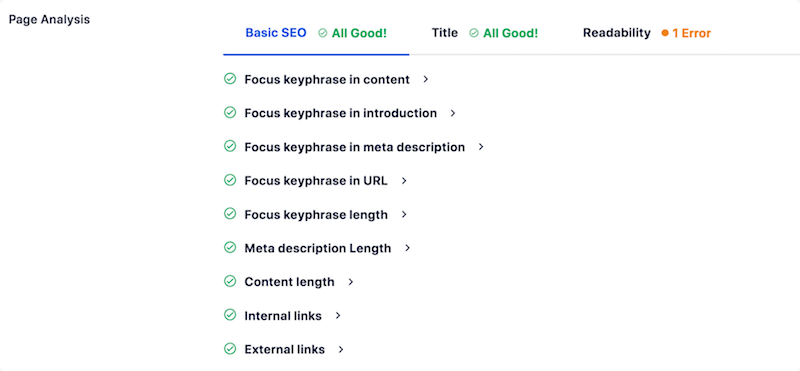
This plugin helps you seamlessly optimize your digital product copy and site content. It provides guidance on targeting specific keywords and improving the readability of your copy.
Search engine algorithms are ever-changing. Stay on top of current trends and adjust your product copy accordingly.
Craft a Compelling Elevator Pitch
You may have as little as 5-10 seconds to keep visitors’ attention and convert them from a potential customer to a paying customer. A compelling elevator pitch is essential. Your pitch should be three or so sentences describing the value and benefits of your product.
After your initial elevator pitch, follow up with bullet points that outline your product features in more detail. This dual approach gives the customer what they want in an easy-to-find format.
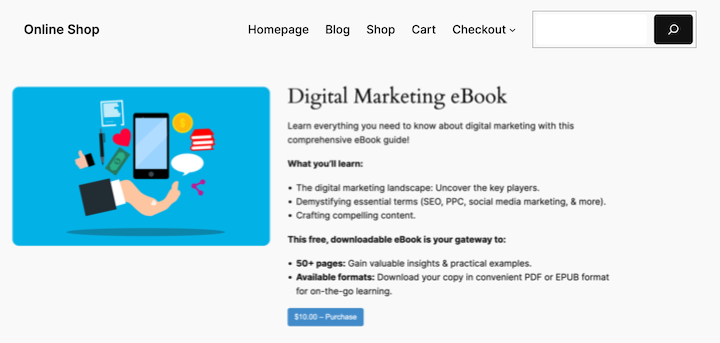
This advice is all the more true when you consider the number of visitors to your site on the smaller screens of mobile devices. According to Statista, mobile phones account for about half of all website traffic worldwide.
On the smaller screen, it’s all about clarity. If you’re too wordy or the info isn’t easy to find, it will be harder to convert that customer.
Focus On Benefits and Outcomes
Product descriptions are more than just a list of features; they’re a powerful tool for persuasion. To truly engage potential customers and drive sales, your product description writing needs to be clear, concise, and captivating.
Focus on outcomes. Instead of simply listing features, explain how the product will benefit the customer.
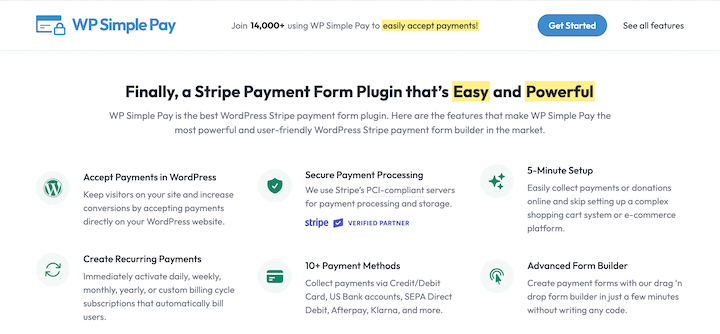
Show that you understand their challenges and frustrations. Then communicate how your product can alleviate their pain points and make their life easier or better.
- Does the product save time and/or money?
- Is the product of higher quality for the price point?
- Do you offer a product demo that makes using your product easier, providing additional value to your customer?
- Is it easy to obtain customer support before, during, and after the purchase?
Help the customer visualize themselves using the product and enjoying its benefits.
Use Persuasive and Action-Oriented Language
When crafting your headlines and product descriptions, get straight to the point. Use clear and concise language. Avoid long, convoluted sentences.
Strong verbs and action-oriented language create excitement and a sense of urgency. For example, instead of saying “This product has a long battery life,” say “This product empowers you to stay connected all day long.”
Employ power words. Words like “guaranteed,” “proven,” and “exclusive” can increase the perceived value of your product.
Consider Advanced Digital Copywriting Techniques
To further enhance the persuasiveness of your digital product copy, consider exploring and implementing advanced copywriting techniques like AIDA and the PAS formula.
- AIDA (Attention, Interest, Desire, Action). The AIDA model is a tried-and-true way to write copy. It helps you structure your content to grab attention, get people interested, make them want what you’re selling, and then get them to take action. It’s like guiding your readers through a journey that builds excitement and encourages them to do what you want, like buy your product.
- PAS (Problem, Agitate, Solve). The PAS formula is another powerful copywriting technique designed to address your target audience’s pain points and present your product as the ultimate solution. By acknowledging the problem, agitating the pain, and then presenting your product as the solution, you create a sense of urgency and make it clear how your offering can resolve their specific challenges.
Use Social Proof to Boost Buzz
Product reviews, customer testimonials, and other forms of social proof can enhance the buzz around your digital products.
If you sell digital products, Easy Digital Downloads makes collecting and displaying product reviews incredibly easy.
Reach out to existing customers to request feedback or a review. You can incentivize them by offering a reward or discount.
Add these testimonials to your email campaigns, product pages, homepage, etc.
Break Up Digital Product Copy Text
There’s a lot of truth in that old saying, “A picture is worth a thousand words”. Never underestimate the value of a compelling photo, graphic, or video that highlights what your digital product can do.
Infographics are a great way of telling your story. You can do product comparisons, highlight benefits in pricing tiers, or showcase milestones. Think of them as graphic bullet points.
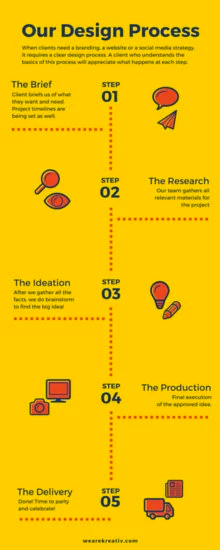
Use templates from online design tools to get started.
You can also break up text with bullet points. This makes the information easier to scan and digest.
Add Clear Calls To Action
A strong call to action (CTA) can significantly impact your conversion rates.
Make sure that when you’re writing your digital product copy, you create strong CTAs that are prominently placed. Tell your audience exactly what you want them to do.
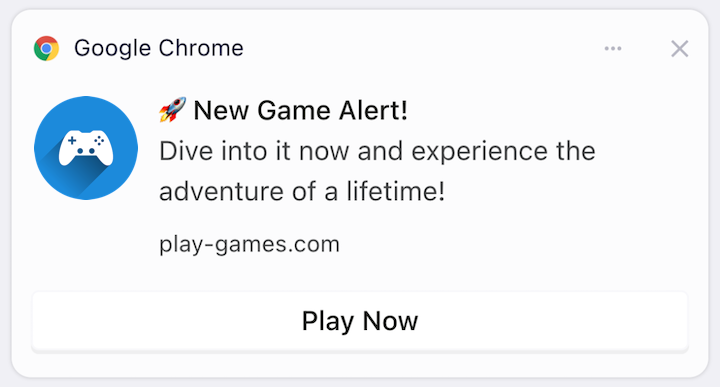
Create a sense of urgency. Use phrases like “limited time offer” or “while supplies last.”
Offer a strong guarantee or warranty. This can help alleviate any concerns your customers may have.
Proofing and Reviewing Digital Product Copy
Before you hit publish, proofread and review your digital copywriting.
Spellcheck and grammar check won’t catch everything. Take a break and come back to see if anything needs changing.
Ask someone else to proofread, review, and edit it. Having a fresh pair of eyes to triple-check your copy is one of the most important things you can do to avoid disaster. An outside perspective can point out things you may have missed or never considered.
Consider writing several versions of copy for one product. Don’t settle with your first iteration – keep writing until you feel like you’ve cracked it, and then show it to someone else for feedback.
A/B testing is a great way to improve your copy over time. By testing different variations of your copy, you can identify what works best and what doesn’t.
If it’s in your budget, you could always hire a professional copywriter or use digital copywriting services.
FAQs on Digital Product Copywriting
Let’s wrap up with some frequently asked questions.
How do I write engaging product descriptions?
A well-written product description can make or break a sale. Here are some tips for creating effective product descriptions.
- Highlight key features and benefits: What makes your product unique?
- Use strong, active verbs: Make your copy more engaging.
- Write in a conversational tone: Talk to your audience, not at them.
- Use social proof: Testimonials and reviews can help build trust.
What are the key elements of effective digital product copy?
Effective digital product copy should clearly convey the product’s value, addressing customer pain points and prompting action. Persuasive language and storytelling build trust, while SEO optimization ensures visibility.
Is copywriting a form of digital marketing?
Digital copywriting is an essential aspect of digital marketing. It helps businesses connect with potential customers, showcase the value of their offerings, and drive conversions in the increasingly competitive online marketplace.
Use EDD to Streamline Digital Product Copy
By following these tips, you can write product descriptions that are not only informative but also persuasive and engaging. Remember, your goal is to create a connection with the reader and convince them that your product is the solution they’ve been searching for.
If you’re looking for an eCommerce solution for digital products? Grab an Easy Digital Downloads pass and learn why it’s a popular choice for creating, optimizing, and promoting digital products online!
Want to learn more digital marketing tips? Check out effective digital marketing channels for promoting your online business!
📣 P.S. Be sure to subscribe to our newsletter and follow us on Facebook, Twitter/X, or LinkedIn for more WordPress resources!
Illustration by Jessica Johnston.
Using WordPress and want to get Easy Digital Downloads for free?
Enter the URL to your WordPress website to install.
Disclosure: Our content is reader-supported. This means if you click on some of our links, then we may earn a commission. We only recommend products that we believe will add value to our readers.